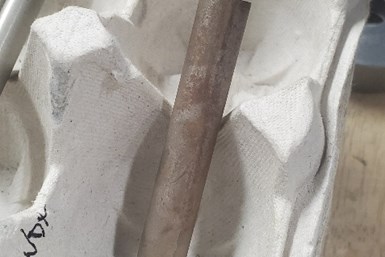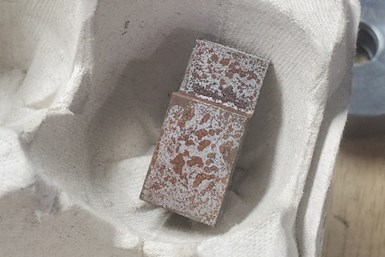ALERT: An Unintended COVID Consequence
Are you experiencing unexpected oxidation and severe pitting on your molds and mold components? Well, it could be due to the additional cleaning the coronavirus has forced upon shops this year.

I recently spoke with Geri Anderson, marketing director for M. R. Mold & Engineering—an LSR mold manufacturer—out in Brea, California, about the sudden appearance of oxidation and severe pitting on the molds and mold components the shop has manufactured during the past 6 months.
It was noticed in-house on a mold that M. R. Mold built that oxidation was occurring on the components. After the initial discovery, they also noticed core pins of a mold that had been sampled had signs of rust. Those pins ultimately had to be replaced before shipping the mold.
“The first incident was no big deal. The second one we dealt with, but when the third incident occurred we said we need to figure out what's going on here,” Anderson says.
After consulting with Rick Ziebell, a technical fellow at R.D. Abbott Company, they identified the culprit as the cleaning solution they were using for the shop’s COVID-related cleaning regimen. Think about it, like many shops, M.R.’s initial instinct to combat COVID was to bleach everything in the entire building—machines, tables, chairs, doors, etc. It turns out that the hand wipes and sanitizer they used to clean their hands and wipe down machines, for example, contain ammonium chloride, which can lead to oxidation and severe pitting after baking at temperature.
“Our conscientious cleaning brought about unexpected result. Our guys were wiping their hands and faces and then touching a mold or mold component,” Anderson says.
Not only did M.R. confer with Rick Ziebell, but also performed a series of tests using various cleaning fluids to be sure. They took M2 and 420 stainless components, wiped them down with cleaning solutions, and then put them both in an oven at 350oF for 3 hours, and they both experienced the oxidation and pitting.

Test #1: M2 wiped down with bleach, placed in an oven at 350oF for 3 hours. Result: oxidation and pitting. Images courtesy of M.R. Mold & Engineering.
“The reality of how much this was costing prompted us to look into what was happening,” Anderson says.

Test #2: 420 stainless wiped down with bleach, placed in an oven at 350oF for 3 hours. Result: oxidation and pitting.
Immediately they looked at all the cleaning solutions and disinfectants being used, identified those with ammonium and chlorine and pulled all of it from the shop floor—wipes, soaps, etc.
“We were told that ethanol alcohol wipes are safe, but that everything else must go. We replaced our cleaners to stay safe but to also avoid unnecessary oxidation and pitting,” Anderson says.
Perhaps it is the type of molds M.R. builds (which can be hotter than other plastic injection molds), but who is to know for sure?
It’s all about education now, and M.R. wants to share this experience just in case other mold builders—including mold component, hot runner and steel suppliers— are battling unexpected oxidation and pitting and unable to find the culprit. Consider your COVID cleaning!
Related Content
-
Portable Low-Heat, Non-Arcing Resistance Welder for Mold Repair
Rocklin’s user-friendly MoldMender Micro Welder delivers simple and cost-effective localized repair in-house with precision and versatility, enhancing mold and die durability and reducing disassembly and downtime.
-
What is Scientific Maintenance? Part 2
Part two of this three-part series explains specific data that toolrooms must collect, analyze and use to truly advance to a scientific maintenance culture where you can measure real data and drive decisions.
-
What You Need to Know About Hot Runner Systems and How to Optimize Their Performance
How to make the most out of the hot runner design, function and performance.
.jpg;maxWidth=970;quality=90)















